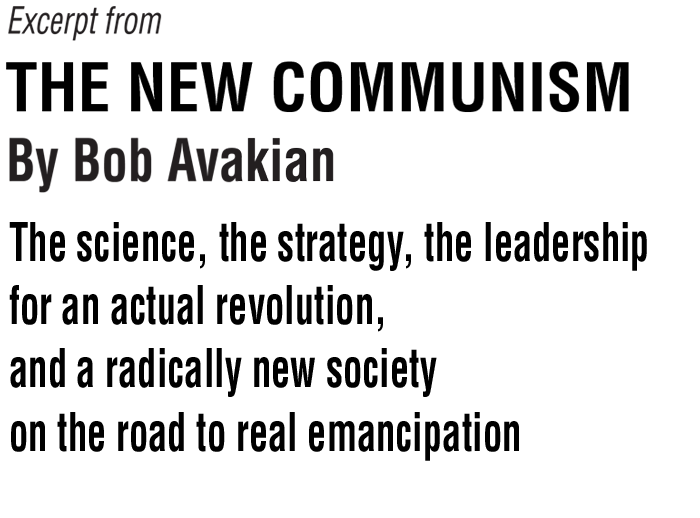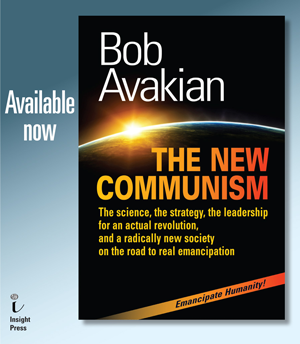
Excerpt from the section:
The Cultural Revolution Within the RCP
Editors' note: The following is an excerpt from the new work by Bob Avakian, The New Communism. In addition to excerpts already posted on revcom.us, we will be running further excerpts from time to time on both revcom.us and in Revolution newspaper. These excerpts should serve as encouragement and inspiration for people to get into the work as a whole, which is available as a book from Insight Press. A prepublication copy is available on line at revcom.us.
This excerpt comes from part of the section titled “The Cultural Revolution Within the RCP,” and is accompanied by the Table of Contents for the work as a whole.
From the section:
The Cultural Revolution Within the RCP
Now, here, let me speak to the question: Why was I doing the work I was doing? Once again, we’re back to for whom and for what. I wasn’t doing this work for myself. When I was young, in middle school and then even more so in high school, my life got changed in a very major way by coming into contact with people that I hadn’t really known that much before, in particular Black people. I started learning about their situation and how that relates to what goes on in this society as a whole. I was drawn to the culture—not just the music and the art overall, but the whole way of going through the world—of the Black people who became my friends, and the world they introduced me to. And I came to the point of recognizing: these are my people. Now, I knew they had a different life experience than I did. But these are my people—I don’t see a separation—it’s not like there are some other people “over there” who are going through all this and somehow that’s removed from me. These are my people. And then I began to recognize more deeply what people were being put through, the oppression they were constantly subjected to, the horrors of daily life as well as the bigger ways in which the system came down on them. And as I went further through life and began to approach the question of what needs to be done about this, and was introduced to taking up a scientific approach to this, I realized that my people were more than this. I realized that my people were Chicanos and other Latinos and other oppressed people in the U.S.; they were people in Vietnam and China; they were women...they were the oppressed and exploited of the world...and through some struggle, and having to cast off some wrong thinking, I have learned that they are LGBT people as well.
These are my people, the oppressed and exploited people of the world. They are suffering terribly, and something has to be done about this. So it is necessary to dig in and systematically take up the science that can show the way to put an end to all this, and bring something much better into being. You have to persevere and keep struggling to go forward in this way. And when you run into new problems or setbacks, you have to go more deeply into this, rather than putting it aside and giving up.
Contents
Publisher's Note
Introduction and Orientation
Foolish Victims of Deceit, and Self-Deceit
Part I. Method and Approach, Communism as a Science
Materialism vs. Idealism
Dialectical Materialism
Through Which Mode of Production
The Basic Contradictions and Dynamics of Capitalism
The New Synthesis of Communism
The Basis for Revolution
Epistemology and Morality, Objective Truth and Relativist Nonsense
Self and a “Consumerist” Approach to Ideas
What Is Your Life Going to Be About?—Raising People’s Sights
Part II. Socialism and the Advance to Communism:
A Radically Different Way the World Could Be, A Road to Real Emancipation
The “4 Alls”
Beyond the Narrow Horizon of Bourgeois Right
Socialism as an Economic System and a Political System—And a Transition to Communism
Internationalism
Abundance, Revolution, and the Advance to Communism—A Dialectical Materialist Understanding
The Importance of the “Parachute Point”—Even Now, and Even More With An Actual Revolution
The Constitution for the New Socialist Republic in North America—
Solid Core with a Lot of Elasticity on the Basis of the Solid Core
Emancipators of Humanity
Part III. The Strategic Approach to An Actual Revolution
One Overall Strategic Approach
Hastening While Awaiting
Forces For Revolution
Separation of the Communist Movement from the Labor Movement, Driving Forces for Revolution
National Liberation and Proletarian Revolution
The Strategic Importance of the Struggle for the Emancipation of Women
The United Front under the Leadership of the Proletariat
Youth, Students and the Intelligentsia
Struggling Against Petit Bourgeois Modes of Thinking, While Maintaining the Correct Strategic Orientation
The “Two Maximizings”
The “5 Stops”
The Two Mainstays
Returning to "On the Possibility of Revolution"
Internationalism—Revolutionary Defeatism
Internationalism and an International Dimension
Internationalism—Bringing Forward Another Way
Popularizing the Strategy
Fundamental Orientation
Part IV. The Leadership We Need
The Decisive Role of Leadership
A Leading Core of Intellectuals—and the Contradictions Bound Up with This
Another Kind of “Pyramid”
The Cultural Revolution Within the RCP
The Need for Communists to Be Communists
A Fundamentally Antagonistic Relation—and the Crucial Implications of That
Strengthening the Party—Qualitatively as well as Quantitatively
Forms of Revolutionary Organization, and the “Ohio”
Statesmen, and Strategic Commanders
Methods of Leadership, the Science and the “Art” of Leadership
Working Back from “On the Possibility”—
Another Application of “Solid Core with a Lot of Elasticity on the Basis of the Solid Core”
Appendix 1:
The New Synthesis of Communism:
Fundamental Orientation, Method and Approach,
and Core Elements—An Outline
by Bob Avakian
Appendix 2:
Framework and Guidelines for Study and Discussion
Notes
Selected List of Works Cited
About the Author
 Download PDF of entire work
Download PDF of entire work